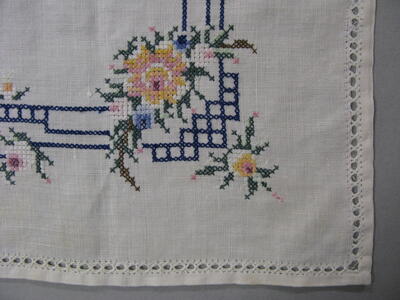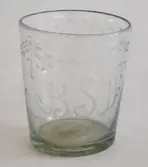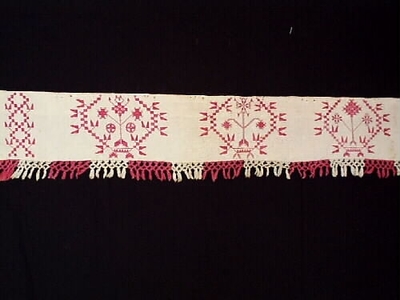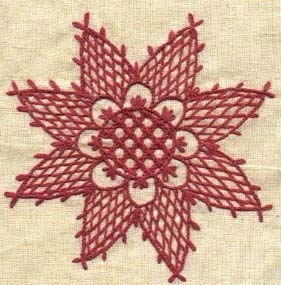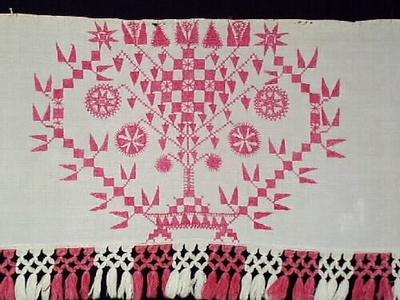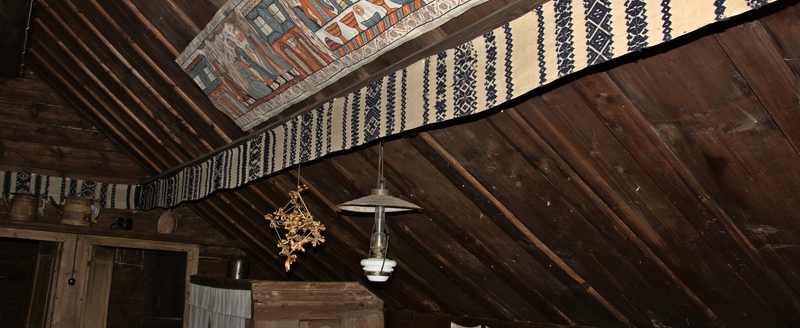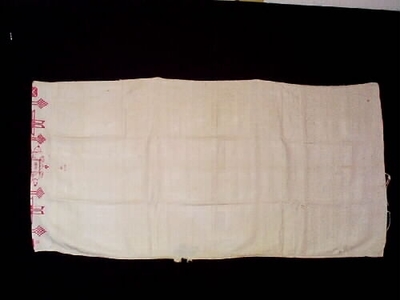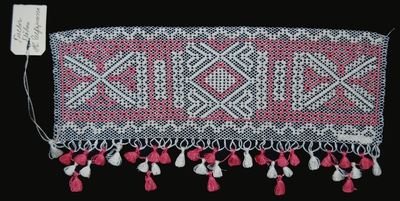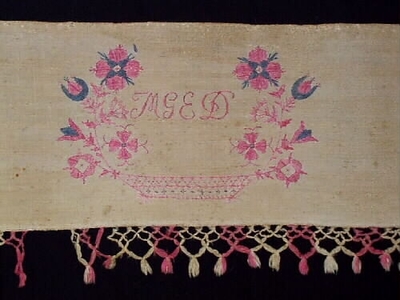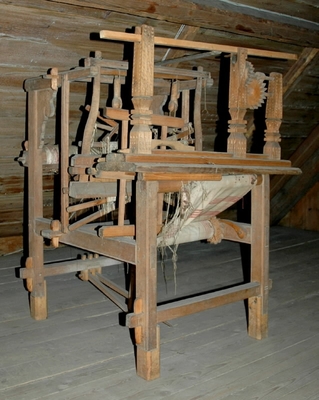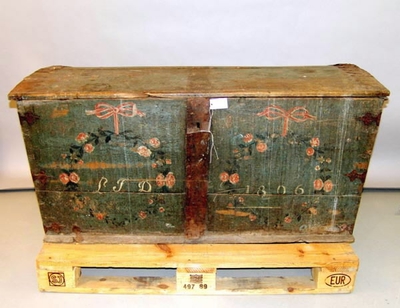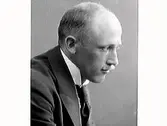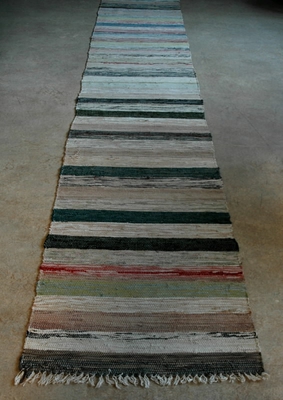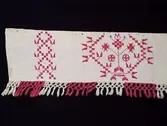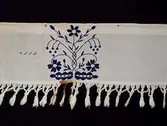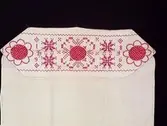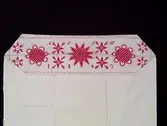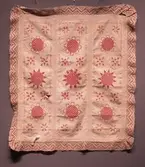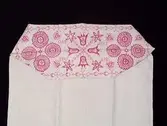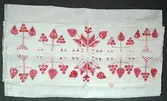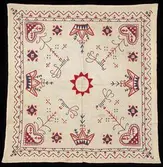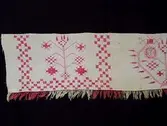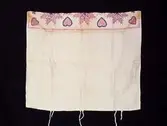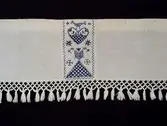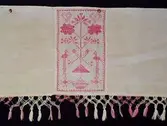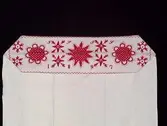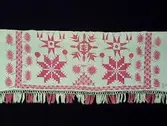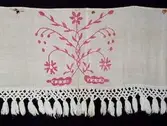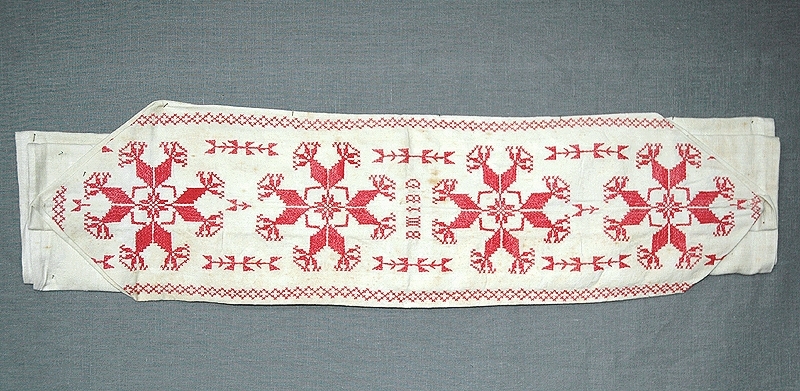
Hallandssöm - a way to the past
When it comes to embroidery, most counties in Sweden have some sort of traditional patterns. They are called regional stitch. Embroidery has for a long time been part of the human history. Many of the stitches used in embroidery started out as used for practical purposes i.e. stitching garments together, but, as time passes, they also became purely decorative. In Sweden, in some regions, embroidery developed in a special traditional and pattern-specific way. In the county of Halland our regional embroidery tradition is called Hallandssöm.
What are regional stitching traditions?
Regional stitch, or province stitch, is the name used about embroidery that locally have a tradition of combining certain patterns and stitching. They are often named after the town or region where they are most common. Mostly they are in crewel technique with few rules on how to do the different stitches. The opposite are more strict stitching rules, where the threads in the fabric are counted individually for a more exact result. Early embroidery often imitated lace or woven cloth. Linen fabric woven locally were often coarse and the threads of the fabric could easily be counted. But, when the more tightly woven cotton fabrics appeared, it made crewel embroidery much easier. Crewel embroidery is easier done on tightly woven fabric. Stitches like satin stitch, whipped stitches, long and short stitch, knots, padded stitches, chainstitch and running stitch is used in crewel.
Embroidery was widely used for decorating hanging pieces of fabric (used as a decoration and it consisted of embroidered strips of fabric), tablecloths, pillow cases, sheets and parts of traditional costumes. The different patterns were mostly sketched directly on the fabric, often with the help of anything handy. For example, a round form could be sketched with the help of a glass, a button or a coin, even a piece of birch bark could be used. To save on the expensive thread, stitches where you could have as little thread as possible on the back of the fabric, was preferred. Satin stitch, for example, could be stitched in a way so that you used as little thread as possible. Tablecloths were often finished off with a fringe. The tradition of embroidery lived on through the ages. Some counties were more well-off and farmers could afford having several employees and that meant more spare time for producing handicraft. The farmer could show that the farm was well-off and that the farmer could afford staff to take time of work to make handicraft items. In the mid-19th Century synthetically coloured threads was invented and it became possible for the more well to do farmers to buy this more expensive thread.
What is Hallandssöm?
Embroideries made in the county of Halland between late 18th Century and late 19th Century are commonly named Hallandssöm. As many of these embroideries have a date stitched on to them, researchers have been able to pinpoint these years. A lot of embroideries were preserved in the North of the county of Halland.
The patterns and stitches used in Hallandssöm can differ a bit between different parts of the county, but locally they are usually more uniform, in terms of composition.
Fabric and colours
Before cotton fabric arrived in Sweden, linen fabric, made in tusk shaft technique, are normally used. Linen fabric weaved in other, more dense ways are sometimes also used. Hallandssöm is always stitched as embroidery with hand drawn patterns. The thread used is a multithreaded yarn, loosely twisted (in early work of linen and later of cotton) and in red and a combination of red and blue. Sometimes red is used in combination with white or the embroidery is done solely in blue. There’s also examples of white-on-white fabric. The museum has noticed that in the North part of the county red is pre-dominant and further South the combination of red and blue is more commonly used.
Patterns, variations and technique
The patterns used has a variation that spans quite a lot of different shapes, for example stars, hearts, squares and circles. Like most regional stitches the shapes were drawn by the help of things like cups and buttons. They were then filled with trellis work and with different couching techniques, one of the characteristics of Hallandssöm. Hallandssöm consist of trellis work, where the different couching methods often were held down by small cross stitches. Sometimes also with the use of shadow stitching. The shapes are then bordered with stitches like stem stitch, chain stitch or blanket stitch. The stitched forms were also used to cover larger surfaces.
Herringbone stitch, more or less closely stitched, is also a common trait in Hallandssöm. The tree of life in different shapes is common. It’s usually drawn quite straightly and stitched with triangles, squares and different shaped stars (preferably with eight points). Embroidered cross stitch, herringbone stitch is common, also blanket stitch, stem stitch, lazy daisy stitch, satin stitch (with as little thread as possible on the back of the fabric) and double cross stitch. Herringbone stitch is common and occur in different varieties. Fly-stitch and chain stitch are also present in older Hallandssöm. Some works are embroidered solely with cross stitch. In a lot of the Hallandssöm works the thread is mainly visible on the front and at the back of the fabric is just very small stitches, you can see that the stitcher has just quickly done a small stitch and then put the needle up to the front again. This is because thread was expensive and you wanted to use as little of it as possible. As with all handicraft, the person responsible for stitching has put their own preferences in their work and done their own composition of the motive motif.
What does the different shapes represent?
From where these patterns and shapes come from is hard to tell. Well-off people could already in the 17th Century buy special pattern books, but the ordinary people didn’t have the means to buy these books and inspiration had to come from elsewhere. From where inspiration came is unknown, but could have been inherited objects, like hanging fabric cloths or pillow cases, handed down in extended families. Their own imagination plays a part and also the Bible, because many of the motifs used have biblical references.
A researcher of Hallandssöm, Irene Karlsson, means that many of the forms common in the North of the county is connected to Christian trinity symbols for God, Christ and the Holy Spirit. They could also be connected to human togetherness, like faithfulness, being true, unity between mankind, love, heaven above and life after death, according to Irene. The very same symbols occur much earlier in carpets from Iran, Turkey and Afghanistan. The shapes also occur very early before Christianity in different incantations against dark powers. Maybe something of this has survived and are kept alive in these embroideries.
What kind of items are stitched in Hallandssöm?
In older times Hallandssöm appeared in the form of hanging fabrics and pillow cases. The hanging pieces of fabrics were used at different kind of festivities. They adorned the house. Sometimes they were woven fabric cloths with different patterns woven in, sometimes embroidered on fabric without woven-in patterns. The woven fabric cloths occurred mainly in the South part of the County. Embroidered hanging fabrics instead occurred mainly in the North part of the County.
The hanging fabrics could have different lengths. Normally they were 25 to 35 centimetres wide and between 2 to 10 meters long. Most often there were a large in the middle, with a monogram and the year it was stitched. On each side of this middle motif the drawn figures mirrored each other.
The Pillow cases were normally quite large and embroidered on the shorter side, the side that lies towards the room. As the embroidery was done on the side of the cushion it didn’t wear out in the same way as the rest of the cushion. When, during the 20th Century, an inventory of textiles from the 19th Century was made by Halländska hemslöjdsförening (written about in Vår bygd 1962) it turned out that wear and tear on the embroidery was minimal, but the rest of the cushion was more worn out.
The hanging fabrics could at the bottom be closed off by finished with a tied fringe, made by hand, a bell-like fringe (kläppfrans) or a crocheted one. Depending on the fabric the fringe can either be sewn on afterwards or be made directly from the cloth by taking away threads in one direction and then making the fringe. A fringe is made by tying or knotting in a lace-like pattern with the end of the thread hanging down. A bell-like fringe consists of knotted loops and on the loops, there are tied tassels in a bell-like shape. The fringes could be widely varied in any size, length or any amount of width. The fringe could be coloured white or white and red.
How to make textiles needed in a household
Who stitched these embroideries? It could have been young girls, but also a specialist.
To marry took time
During the 18th and 19th Century, when a girl from Fjäre, Viske or Himle precinct, became old enough to start thinking about marriage, she started to collect textiles to her bridal chest and dowry. The bridal chest, and its contents, were her property for the rest of her life. The fabric wasn’t bought. It was made at the farm itself, from sowing the flax, to harvesting, treating it in several different stages and finally the flax was woven to a fine and supple linen fabric. Ideal measurements for this fine and supple linen fabric were about 65 cm broad and 14 to 20 meters long. The fabric must be long enough for the girl to make not just hanging fabrics and pillow cases, typically for Hallandssöm, but also for bridal sheets and the bride and grooms wedding clothes.
The weaving of the fabric took a large part of a Winter to do. Afterwards, in Spring, it had to be laid out in the sun to whiten, often on special whitening slopes. Considering the time and work spent on the making on the fabric, it was well guarded while laid out. It was an expensive and valuable fabric. When all the fabric needed was used for the above-mentioned textiles, the rest of it was turned into a shroud for the day that death came and took you away. The weaving took place in the Winter, but the stitching of the embroideries was done in the Summer. To do the stitching you needed daylight since it was better than other lightssources available. A complete set of textiles for your home was a status symbol, a sign that the household was well-to-do.
Embroidery specialists
Certain rules of Hallandssöm existed, but composition and the skill of embroidering varied, from young girls not familiar with embroidering, to obvious specialist at the craft. The young girls stitched for their dowry. Some of the female embroidery specialist are known by their name, and it’s documented that they accepted orders for stitched textiles. One of them was Beata Kristina Kristensdotter, born in Landa parish 1811. After marriage she moved to Frillesås and, later, Gällinge parishes. She became a prolific embroideress. Her work is distinguished by her richness of different shapes and she stitched both traditional cross stitch and other types of embroidery. Another skilled embroideress was Mariana Persson from Förlanda parish and she was born on the farm Gränshult in 1851. Mariana took orders for embroidery and weaving from local people and did all the pattern making herself. Often using saucers, she then filled it up with trellis work from her own imagination. Much of her inspiration came from Christian motifs, for example the Luther rose.
Embroideries took time. Albert Sandklef (in 1958) told about a hanging fabric he got from his father, who in his turn had got it from his father. It was made for Sandklefs grandparents’ wedding. It wasn’t finished until three years after the wedding. Like much of handicraft, quality was more important than speed. A daughter of a farmer with big landholdings, and therefore well-to-do, could let a maid do all the weaving of the linen dowry instead of herself. She could then let a skilled embroideress do all the embroidery needed. This was a source of income for poor, often single, women. For a skilled embroideress it took about 40 hours of stitching for a hanging fabric, but for an inexperienced stitcher it could take three times as long.
Marbosöm and Hallandssöm – alike, but different
If you look at the Marbosöm from the neighbouring region of Mark, you can see it’s a bit like Hallandssöm. Both have trellis work in circles, hearts and of the tree of life. They are also stitched roughly in the same way. The difference is mainly that Hallandssöm are more strict, with very exact geometrical shapes, while the Marbosöm normally is more freely flowing. In Marbosöm the geometrical shapes are mixed with flowers and birds with stitching more individual than in Hallandssöm. Hallandssöm mostly consists of geometrical shapes, like triangles and squares, often stitched pre-dominantly in red. The likeness of the shapes and stitching isn’t strange. In older times borders were not important and ideas, and patterns, flowed freely between different regions.
Hallandssöm in modern times
In the beginning of the 20th Century things started to change. Those richly embroidered hanging fabrics and also the pillow cases disappeared from the household textiles. The way people made their beds and the different pieces of fabric needed changed, and the old pillow cases were used until worn out. Housing changed and these kinds of textiles were not used in the same way as they used to be. An example is that in the common man’s home the rag rug made its debut in the second half of the 19th Century. Raised standard of housing and cheaper materials meant a change in fabrics used. But, even though embroidering of Hallandssöm declined, there were still older people that could embroider Hallandssöm, mostly in the form of travelling salesmen. For example in Gothenburg lived an old lady, a ”Hallandsgumma” (literally an old woman from Halland), that wandered from house to house selling her wares, often different sized table cloths. These table cloths bore witness to a change in taste and the way the shapes were stitched. They had the same shapes, but they were not as strictly adhering to older traditions of stitches used, or so well balanced in their distribution of the different embroidered shapes as they used to be. Several companies including Nordiska Industri AB (NIAB), were selling material for handicraft and they had also finished items like Hallandsöm available.
The foundation of Swedish handicraft associations
The first Swedish handicraft associations are started at the beginning of the 20th Century. According to Britta Johansson, the first handicraft association in the county was started 1911, and it’s unclear if this was the only one. Anyhow, Halländska Hemslöjdsföreningen Bindslöjden was founded in 1911. Early on the goal was to preserve the knowledge about Hallandssöm. The association copied old embroideries and created new patterns based on the old one's design language. Several Hallandssöm embroideries was shown at Baltiska utställningen in Malmö 1914. At the creation of the handicraft association a pattern book was released by Ellen Domenicus in 1927. Baroness Lotten Hermelin at Fröllinge, in Getinge parish, was for many years chairman of the board, and she was very active in the work of preserving Hallandssöm. An inventory in 1957 resulted in many photographs and notes about Hallandssöm, and they were kept in the association’s archive. The handicraft association has also had craft shops, where customers could buy materials for stitching and ready-made kits. The association has also had many exhibitions of their, by the association, newly produced embroideries of Hallandssöm, like table cloths, curtains, cushions, lamp-shades and much more. A diversity of textile designers has been employed to update old patterns, but also to create new ones. Several private persons, notably Irene Karlsson, has also engaged themselves in the preservation of Hallandssöm. Irene Karlsson was by Kungsbacka municipality rewarded for her work in relation to the preservation of Hallandssöm. Parts of her collection is today preserved at the county museum. If you want to learn to embroider Hallandssöm, the study associations and the handicraft association have courses now and then.
Finally
Like all regional embroideries, Hallandssöm might seem a thing of the past. Nowadays we don’t take the time to embroider projects as we did before. At the same time, it’s a connection to the past, to those that came before us. It’s a cultural tradition, easily forgotten by the ever growing and developing society. In today's society many are regarding embroidery as a relaxing handicraft, but sometimes also a rebellious gesture (for example in visible mendings). Also, like regional stitching, it’s a way to connect to the past. But, maybe much more, it’s a reminder of days gone by, when time didn’t matter so much, and a slower way of life than we have today.
Suggestions for further reading
- Eggimann-Jonsson, Ingrid (1998). Svenska broderier.
- Holmberg, Karin (2018). Svenska broderier.
- Johansson, Britta (1977). Hallandssöm.
- Skantze-Ärlemalm, Inger (2010). Hallandssöm: hängkläden och pudevar från norra Halland.
The regional museum collection
The museum has in its collections several items in Hallandssöm, with different colour and mainly hanging fabrics and pillow cases. Here is a selection.
